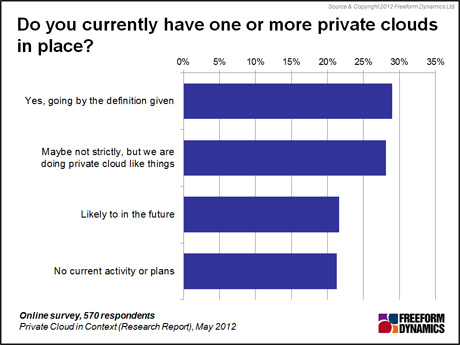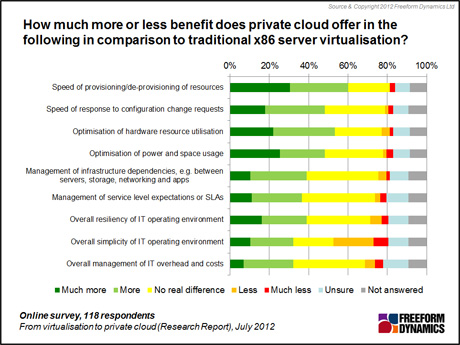Will every data centre become a cloud?
As nearly everyone working in IT understands, things never stand still for long. Over the past couple of years many large organisations have undertaken a significant amount of work using software virtualisation solutions to help optimize the operations of their x86 server estates. This has resulted in considerable numbers of virtual servers being run on fewer physical systems, while supporting a growing range of business applications.
For many organisations the server consolidation achieved via virtualisation appeared to deliver significant cost savings, at least in terms of Capex although management challenges have arisen. Collateral benefits experienced also often include improved application availability and resilience, but these may be hard to quantify in terms of ‘value’. Many data centres are now looking at using storage and, to a lesser degree, network virtualisation to derive similar cost and service quality benefits.
But as virtualisation becomes embedded in mainstream data centre operations, is this the end of the road or are there other developments likely to push it ever-forwards? Many vendors are currently promoting the concept of ‘Private Clouds’ as a logical extension of virtualisation and have it poised to sweep through data centres. Recently Freeform Dynamics undertook a series of studies1 to look at just what data centre staff thought about private cloud and the state of play today.
Figure 1 illustrates results obtained from an online survey looking at attitudes to and existing experience of private clouds. The survey started by defining Private Cloud as being based on the idea of “pooling servers, storage and networking to create a shared general-purpose platform upon which a variety of workload types may be run simultaneously. Rapid allocation/de-allocation of resources to/from workloads in a private cloud environment enables a more dynamic management approach.” Few respondents disagreed with this description.

Figure 1
As can be seen from Figure 1, around one in four state that they already have one or more private clouds in operation. On the surface this figure appears to be not that small, but it must be recognised that any online survey is liable to be subject to some ‘self-selection effects’. In particular we know from long experience that many people attracted to take part may be very interested in the particular area under study, and could even be early adopters of the solutions be discussed.
But of even more interest is that a similar proportion of respondents answered that whilst they may not formally have a private cloud in operation, in some respects they are already undertaking ‘private cloud like things’. These may include automatically moving virtual machines (VMs) as resources are stressed on physical servers or dynamically reallocating memory / CPU / networking etc. to VMs as circumstances alter. IT might also include allowing certain users to self-provision service or
Around a fifth state that they are likely to undertake the development of one or more private clouds in the future with a similar proportion saying they have no such plans at all.
From this we can safely deduce that while real world deployment of private cloud solutions is quite low, it appears to be both reasonably well understood, at least as a concept, and that many organisations see it potentially playing a role in the future of their IT service delivery.

Figure 2
When pressed on what advantages would be expected from private cloud beyond those inherent in x86 server virtualisation (Figure 2), quite a range of answers were proffered. While cost savings were often a major deliverable expected from server virtualisation programmes, other benefits are expected to feature more prominently in private cloud. Chief amongst these are that the ability to delivery new services or to respond to request for change will improve, coupled with another step up in resource utilisation efficiencies and resilience.
The research also highlights that private cloud is also expected by some improve the management of IT infrastructure dependencies and service levels. This is interesting as the need for organisations to take on new management tools and support processes has often been cited as matters that require attention in today’s virtualised environments.
It will be interesting to see if this acknowledgment leads to improvements in the management of virtual systems, and more particularly to refining operational processes and better utilising tools to automate administration. Research we have undertaken over several years indicates that few really understand this or invest here and it remains difficult for many IT departments to get approval to acquire new management tools. This could place considerable pressure on vendors to ensure ‘private cloud’ solutions are delivered with excellent management tools.
Indeed, getting to grips with complexity and finding new ways to support flexible systems is likely to continue to pose considerable challenges to organisations as the use of virtualisation increases and as private cloud takes off. Given the nature of existing IT systems, and the ways in which they have been funded via project based expenditure, IT budget models may well require modification as shared infrastructure becomes more of the norm.
The journey to virtualised systems still has a long way to run, in all areas of servers, storage, networking and management. Private cloud is only just beginning.
But the effective utilisation of better management tools and new operational processes, especially those linked to change management, need to be adopted quickly. It is clear that whilst not every data centre will transform into a private cloud in the short term, there are considerable benefits available in by operating flexible IT to do private cloud like things. The early indications are that cloud-like environments and the incremental benefits that can accrue through investment in management, automation, policy, service monitoring and the adoption of business-centric SLAs etc. are matters that many data centres might well wish to investigate.
